
A World Heritage Site is a landmark or area with legal protection by an international convention administered by the United Nations Educational, Scientific and Cultural Organization (UNESCO). World Heritage Sites are designated by UNESCO for having cultural, historical, scientific or other form of significance. The sites are judged to contain "cultural and natural heritage around the world considered to be of outstanding value to humanity".

Neutral Moresnet was a small Belgian–Prussian condominium in western Europe that existed from 1816 to 1920 and was administered jointly by the United Kingdom of the Netherlands and the Kingdom of Prussia. It was 1.5 kilometres (1 mi) wide and five kilometres (3 mi) long, with an area of 360 hectares. After 1830, the territory's northernmost border point at Vaalserberg connected it to a quadripoint shared additionally with the Dutch Province of Limburg, the Prussian Rhine Province, and the Belgian Liège Province. Its former location is represented presently by the Three-Country Point, the meeting place of the borders of Belgium, Germany, and the Netherlands.

Liège is the easternmost province of Wallonia and Belgium.
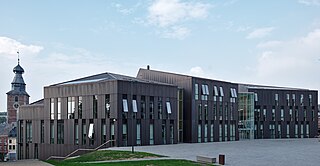
Gembloux is a city and municipality of Wallonia located in the province of Namur, Belgium.

Kelmis is a municipality located in the Belgian province of Liège, named for the historical deposits of calamine nearby. As of 2011, the population was 10,881; the area is 18.1 square kilometres (7.0 sq mi) and the population density is 601.2 inhabitants per square kilometre (1,557/sq mi).
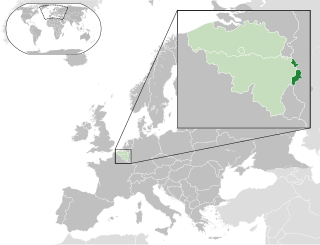
The German-speaking Community, known since 2017 as East Belgium, is one of the three federal communities of Belgium. Covering an area of 854 km2 (330 sq mi) within the Liège Province in Wallonia, it includes nine of the eleven municipalities of Eupen-Malmedy. Traditionally speakers of Low Dietsch, Ripuarian, and Moselle Franconian varieties, the local population numbers 77,949 – about 7.0% of Liège Province and about 0.7% of the national total.

This is a list of the lists of World Heritage Sites. A World Heritage Site is a place that is listed by the United Nations Educational, Scientific and Cultural Organization (UNESCO) as having special cultural or physical significance.
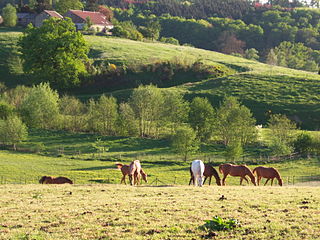
The Geul is a river in Belgium and in the Netherlands, where it is a right-bank tributary to the river Meuse.
Pierre Grignard was a Belgian politician who served as the last Mayor of Neutral Moresnet from 1918 until 1920, when the territory was dissolved and annexed by Belgium as part of the Treaty of Versailles. Grignard subsequently served as the first mayor of the Belgian municipality of Kelmis until 1923.

Falaën Castle is a château-ferme, or fortified farmhouse, in the village of Falaën, municipality of Onhaye, province of Namur, Wallonia, Belgium.

Sombreffe Castle is a medieval castle in Sombreffe, province of Namur, Wallonia, Belgium.

Heritage registers in Belgium include immovable heritage such as World Heritage Sites, and National heritage sites, but also intangible cultural heritage. The agency responsible for keeping and updating inventories of immovable heritage is dependent on the region, as is the name for the object, which is called Beschermd erfgoed, Biens classés or Kulturdenkmal depending on the language of the municipality of the location.

Beschermd erfgoed is the official term to describe Flemish National Heritage Sites listed by law to protect and spread awareness of Belgian cultural heritage, specifically in Flanders. The term is also used nationwide to refer to national heritage sites. Because Belgium is officially a tri-lingual country, the other nationwide terms used in the rest of the country are the French term Bien classé and the German term Kulturdenkmal.
This page is an overview of the list of protected heritage sites in Liège Province, alphabetically ordered by town name. This list is part of the national heritage of Belgium.
This page is an overview of the list of protected heritage sites in Hainaut (province), alphabetically ordered by town name. This list is part of the protected heritage sites of Belgium.
This page is an overview of the protected heritage sites in Luxembourg (Belgium), alphabetically ordered by town name. This list is part of the protected heritage sites of Belgium.
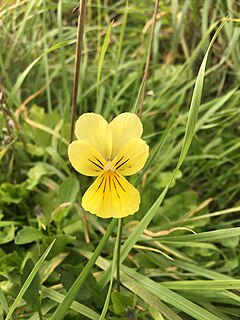
Viola lutea subsp. calaminaria is a subspecies of V. lutea, in the violet family, the Violaceae. The plant occurs from Kelmis in the Belgian province of Liège across the borders to Germany and the Netherlands. The plant has adapted to an excess of zinc in the tailings of a former mines, the heaps of stone left over after separating the valuable fraction of ore. By evolving the ability to cope with the toxic heavy metal pollution, this violet has gained an advantage over the other plants in the ecosystem, as is able to become the locally dominant floral component of such habitats.
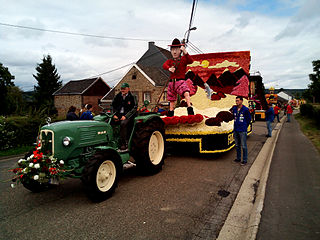
Hergenrath or Hergenraedt is a village and sub-municipality in Belgium. It is located in the municipality of Kelmis in Liège Province, part of Wallonia. It is part of the German-speaking Community of Belgium.

Neu-Moresnet is a village and sub-municipality of Kelmis in the German-speaking community of the province of Liège, Wallonia, Belgium. The village was founded as Prussian-Moresnet as part of the Lower Rhine Province. In 1919, after World War I, it was awarded to Belgium, and renamed Neu-Moresnet. In 1940, it was annexed by Nazi Germany, and in 1944, it was returned to Belgium. Neu-Moresnet was an independent municipality until 1977 when it was merged into Kelmis.























